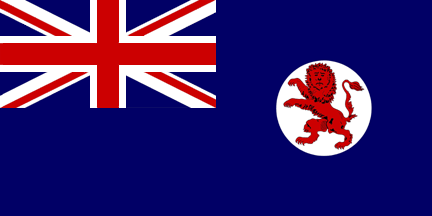 image by Clay Moss, 25 Jan 2006
image by Clay Moss, 25 Jan 2006
Last modified: 2011-06-10 by bruce berry
Keywords: kenya | red lion |
Links: FOTW homepage |
search |
disclaimer and copyright |
write us |
mirrors
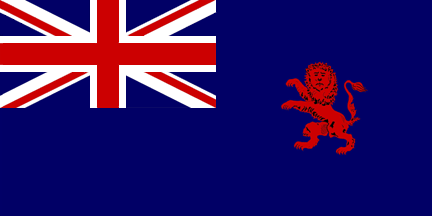 image
by Clay Moss, 25 Jan 2006
image
by Clay Moss, 25 Jan 2006
The Blue Ensign of Kenya, used between 1921 and 1963 was a traditional blue ensign
with the Union Jack in the upper left corner and a blue background. The fly contained a red lion standing on its
hind legs.
James Alcock, 12 Oct 1999
I found three flags and a badge of the Kenya colony without much explanation
in Kannik's Vlaggen, Standaarden en Wapens (n.d.): The blue
ensign has the red lion without the white disk. The lion is "red ensign
red". The other two flags are: Governor of Kenya and the Merchant flag of Kenya
- red ensign with lion in the fly in a white disk.
Jarig Bakker, 13 Oct 1999
 image by Clay Moss, 25 Jan 2006
image by Clay Moss, 25 Jan 2006
The sequence of badges/flags seems to have been:-
1895-1963. Ditto on white disc surrounded by garland on the Union Jack
David Prothero, 30 Nov 1999
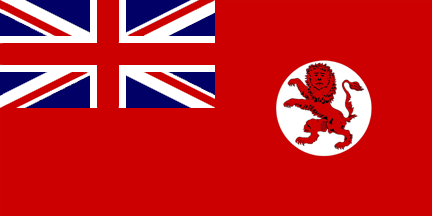 image
by Clay Moss, 25 Jan 2006
image
by Clay Moss, 25 Jan 2006
One of my Vexillology class students noticed that some defacements on British ensigns are placed on the lower part of the fly half as opposed to the middle. It seems to me that it was a more common practice in the early 20th century even though there are current samples of this defacement method. Can anyone shed light on this? Has it traditionally been a manufacturers option, or were/are there specific times when defacements are lowered?
I have attached a Kenyan red ensign (shown below) made from a picture that I have in a book. If anyone
owns a copy of Dhows of Mombasa, there is a very nice turn of the 20th
century picture of a British East African dhow flying the "Kenyan" red
ensign with the defacement in the lower fly. The ensign appears to be perhaps
3x6 feet.
Clay Moss, 19 Sep 2005
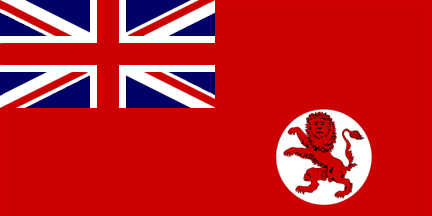 image
by Clay Moss, 25 Jan 2006
image
by Clay Moss, 25 Jan 2006
The centre of the fly has been the correct official position for the
badge on most British ensigns since 1869. The exceptions are yacht club
special ensigns. I have never seen a specific instruction about the
position of the badge on these ensigns and I think that some clubs have
tended to place their badge in the fourth quarter.
It is an unofficial flag anyway. No Red Ensign warrant was issued
for Kenya, nor for the British East Africa Protectorate, which was the
name of the territory until 1920. There was a Red Ensign warrant
for the Imperial British East Africa Company, but that was a different
badge, and was cancelled in 1901.
David Prothero, 19 Sep 2005
There's a pragmatic reason for placing badges in the lower fly; that
being that they are much easier to see in almost any circumstance. This
may have been why manufacturers opted to deface ensigns this way despite
official specifications.
The Kenyan red ensign with the lion is another prime example of a "non-existent"
red ensign that was manufactured and used in
abundance.
Clay Moss, 19 Sep 2005
The flag itself was not illegal. The legality of its use as an ensign would have depended upon the circumstances. It would not have been a legal ensign for a registered ship, and its use in international waters would have been open to question, as it was not an internationally recognized maritime flag. But there was no reason why small dhows, trading along the East African coast, and generally remaining within the territorial waters of the British Empire, should not use it as an ensign, if they so wished. It may locally have been thought that it was the correct ensign, since British Somaliland to the north, and Tanganyika to the south, each had its own warranted Red Ensign.
They were a protectorate and a mandated territory respectively, whose
inhabitants were not British subjects, and were therefore not entitled
to use a plain Red Ensign. It might be argued that Kenya also should have
had a distinctive Red Ensign. Although the interior of the country was
a colony after 1920, the coastal strip, formerly known as Witu,
remained a protectorate. This caused a problem in 1956 when the Board
of Trade Registrar in Plymouth refused to register a ship belonging to
Southern Lines Ltd of Kenya, on the grounds
that the company's head office was in Mombasa, which was in the protectorate
and not the colony. The ship could not sail under the Kenyan Ensign,
since such an ensign had not been warranted, and it could not sail under
the plain Red Ensign as the ship was owned by a company that was not "established
under and subject to the laws of some part of HM dominions." The company
was advised to either transfer ownership of the vessel to another company,
or register it in the name of a British subject, or move its head quarters
to Nairobi, which was within the colony.
Source: National Archives (PRO) BT 239/148.
David Prothero, 26 Sep 2005
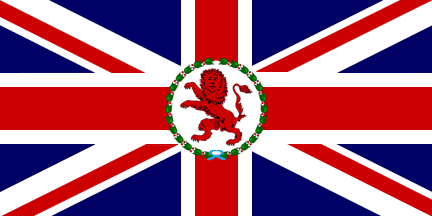 image
by Clay Moss, 25 Jan 2006
image
by Clay Moss, 25 Jan 2006
The flag of British East Africa is the national banner of the Empire,
bearing upon the intersection of the crosses a red lion, rampant, or aggressively
walking forward on his hind legs...encircled by a wreath. No explanation
why British East Africa doesn't follow the badge-ensign model.
Josh Fruhlinger, 13 Feb 1996
![[Governor-General's flag]](../images/k/ke_gg1.gif) image
by Željko Heimer, 22 Mar 2003
image
by Željko Heimer, 22 Mar 2003
We have no information on this briefly (if ever) used flag. From Flags of The
World by Bill Yenne, Published by Bison Books, 1993 [ynn93].
Željko Heimer, 22 Mar 2003
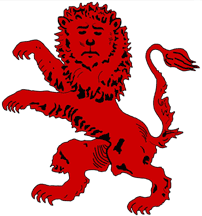 image
by Clay Moss,
25 Jan 2006
image
by Clay Moss,
25 Jan 2006
The famous, and very poorly drawn (Heraldically speaking) Red Lion which defaced the British Blue Ensign of what was British East Africa, and then later Kenya, adorns several flag plates in publications of the highest quality through the ages. We seem to have "settled" on the version from Flaggenbuch [neu39], which in turn, derived the drawing from the British Admiralty one presumes.
David Prothero scanned another version which, would appear to have come from BR20, 1958 [hms58] and the detail of this beast has some differences from the "standard" Kenya Lion. His paws are accentuated whilst his face and main show a greater amount of detail than the British vexillological enthusiast has become accustomed to by familiarity.
From scratch, I decided that this alternative rendering would be worth
a drawing. I depict the
detail on a blue field here below, although the white disk was dropped later
and therefore the Lion placed directly on to the fly of the Blue Ensign.
Martin Grieve, 03 Sep 2005
![[Badge - alternative version]](../images/k/ke)br20.gif) image
by Martin Grieve, 03 Sep 2005
image
by Martin Grieve, 03 Sep 2005
fb.jpg) sent by Clay Moss, 20 Feb 2006 from Flaggenbuch
sent by Clay Moss, 20 Feb 2006 from Flaggenbuch
Martin Grieve commented that he believes the badge I drew was inspired by the "Kenia"
badge in the 1939 Flaggenbuch [neu39]. I
have posted that badge for everyone's benefit.
My badge is (supposedly) drawn from one of the British Admiralty books. I have a
picture of the badge from which I drew my rendition, and the picture is labeled
"Admiralty Lion – Kenya". I have had it for a while, but can't remember who sent
it to me. Anyway, there is an almost exact matching badge in the 1914 edition
of Flags of Maritime Nations. As you all can see, my badge, is not that similar
to Flaggenbuch's badge.
II love and appreciate all the various editions of Flaggenbuch, but have
never considered them to be all that credible when it comes to showing exact
illustrations of British badges. They're functional, but not spot on.
Meanwhile, I have two Kenya blue ensigns in my collection. One is pre-1921 with
the lion on the disk while the other has the lion
defaced directly onto the fly of the ensign. In both cases, they very closely
match the lion I have already posted to FOTW.
I did take a few very slight liberties in modifying the black shadowing in the
lion. Otherwise, the lion would not have been very recognizable on a blue
background.
Other than that, the badge is a faithful reconstruction of what I was sent.
I am aware that there was perhaps one late change (Martin's reference) in
Admiralty art work where Kenya's lion was concerned, but I'm not certain that
the change translated into a different lion ever defacing Kenyan ensigns in
large numbers. Having said that, Bruce Berry does have a Kenya blue ensign with
Martin's basic drawing as a defacement. I have also attached that picture in the
files section. Bruce's ensign was manufactured by William Smith in Salisbury
(Rhodesia) some time back when. It's the only such ensign I have ever seen.
Clay Moss, 20 Feb 2006
Letters of the early 1920's in the Public Record Office, about whether or not colonial badges were displayed in a white circle, make no mention of a Red Ensign for Kenya. However they indicate that the "red lion badge" was displayed on a white circle on the Blue Ensign until 1921.
The sequence of badges/flags seems to have been:-
1895-1963. Ditto on white disc surrounded by garland on the Union Jack
David Prothero, 30 Nov 1999
It seems that the "Red Lion badge" was never warranted for use on the Red
Ensign, and is an error. The earliest book that I have found, that shows
the "red lion badge" on a Red Ensign is the NGM
of 1917 in which it is the only colonial (as opposed to Dominion) badge
that is shown in place on all three flags, the Union Jack, the Blue Ensign and
the Red Ensign. This has been copied by Kannik in the Flag
Book/Handbook of Flags of the 1950's.
David Prothero, 01 Dec 1999